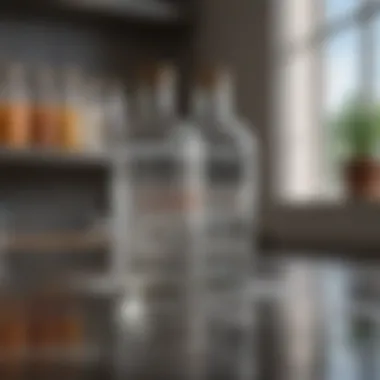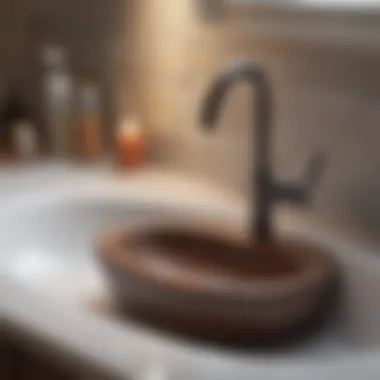Effective Home Remedies to Unclog Your Bathroom Sink


Intro
Unclogging a bathroom sink can be a frustrating task. Clogs often occur due to hair, soap residue, and other debris that accumulate over time. With a plethora of chemical solutions available, many people overlook the effectiveness of home remedies. This article aims to offer practical, easy-to-follow methods to unclog your sink using common household items. By understanding the nature of plumbing issues, readers can maintain their sinks effectively and without relying on harsh chemicals or costly plumber visits.
Understanding Common Causes of Clogs
Clogs in a bathroom sink often stem from a few primary sources. Recognizing these causes can help in both prevention and resolution strategies.
- Hair Accumulation: One of the most frequent culprits, hair can easily accumulate and bind with soap or other debris in the drain.
- Soap Scum: Soap residue can build up over time, especially with bar soaps that do not dissolve easily in water.
- Toothpaste and Hygiene Products: Substances like toothpaste, mouthwash, and other toiletries can contribute to blockages.
Understanding these factors allows you to take proactive measures in preventing clogs. Doing so saves time, effort, and money in the long run.
Simple Home Remedies
Here are effective remedies solely using items you likely already have at home.
Boiling Water
One of the simplest methods involves boiling water.
- Step 1: Boil water in a kettle.
- Step 2: Carefully pour it directly into the sink drain.
This process helps to dislodge minor clogs and clear the buildup of soap scum.
Baking Soda and Vinegar
This combination creates a powerful reaction that can clear clogs.
- Step 1: Pour half a cup of baking soda down the drain.
- Step 2: Follow this with half a cup of white vinegar.
- Step 3: Cover the drain to contain the reaction. After 30 minutes, flush with hot water to clear the residue.
Salt and Baking Soda
Another effective mixture involves combining salt with baking soda.
- Step 1: Mix one cup of baking soda with one cup of salt.
- Step 2: Pour the mixture down the drain.
- Step 3: Let it sit for at least 30 minutes. Finish by flushing with boiling water. This method works well for tough clogs.
Preventive Measures
To minimize future clogs, implement these preventive measures:
- Regularly use a drain strainer. This will catch hair and large debris before they enter the pipes.
- Perform routine cleaning of your drain with boiling water and baking soda every few weeks.
- Be mindful of what goes down the sink. Avoid rinsing debris from products like toothpaste or facial scrubs.
"Prevention is better than cure."
Maintaining your bathroom sink ensures its longevity and functionality. A few simple practices can help avoid the inconvenience of clogs later on.
Finale
Unclogging a bathroom sink does not necessarily require a trip to the store for expensive products. With household items, one can effectively manage most clogs easily. Understanding common causes and implementing preventative methods can maintain the health of your plumbing and avoid future problems.
Understanding Clogs in Bathroom Sinks
Understanding the nature of clogs in bathroom sinks is essential for effectively addressing them. Clogs not only hinder the daily routine but also pose more significant plumbing issues if left unattended. Knowledge about clogs allows homeowners to take proactive measures. It can save time and money by using home remedies rather than relying on professional plumbing services. Understanding the underlying causes of clogs helps in selecting the most effective unclogging methods and prevents future blockages. This section delves into the common causes and symptoms of clogged bathroom sinks, enabling a comprehensive approach to plumbing health.
Common Causes of Bathroom Sink Clogs
Hair Accumulation
Hair accumulation is one of the most common contributors to bathroom sink clogs. This occurs when loose hair from grooming routines collects in the drain. Its key characteristic is its ability to tangle and form a dense mass that traps other debris, making it a significant issue. Hair clogging is a beneficial topic because it highlights a simple, everyday problem that many face. The unique feature of hair accumulation is that it often goes unnoticed until it starts causing issues. Its advantages in understanding clogs include the ability to address it quickly with simple preventive measures.
Soap Residue
Soap residue builds up over time, creating a sticky environment for other materials to cling to. Its primary attribute is its propensity to harden and congeal. Soap residue is also relevant for this article since it combines with other blockage agents like hair and grime, leading to serious clogs. This unique characteristic means that careful cleaning can prevent the buildup from becoming problematic. While addressing soap residue is relatively easy, its buildup can be an overlooked contributor to sink issues.
Toothpaste Build-up


Toothpaste can also contribute to bathroom sink clogs. This issue arises mostly in households where people brush their teeth at the sink. The unique feature of toothpaste buildup is its sticky texture, which combines with water and other waste products to form solid deposits. It is beneficial to take note of this problem as it is often underestimated. Although cleaning toothpaste residue is straightforward, neglecting it can exacerbate drainage issues when combined with other clogging materials.
Foreign Objects
Foreign objects like small toys, cotton swabs, and other debris contribute to bathroom sink clogs as well. Their main characteristic is that they are often accidentally washed down the drain without realizing their potential for blockage. They rank as a serious concern due to the role they play in causing sudden, unexpected clogs. Recognizing the threat of foreign objects can greatly aid in preventing clogs. Their unique nature means that they can vary widely from household to household, making it essential to be mindful of what is disposed of in the sink.
Identifying Symptoms of a Clogged Sink
Slow Draining Water
One of the first indicators of a clogged sink is slow draining water. This symptom denotes that the flow in the pipes is being obstructed. Recognizing this early is advantageous because it provides the opportunity to address the issue before it worsens. Slow draining water is a clear signal of obstruction, and attending to it promptly can prevent more significant plumbing problems.
Unpleasant Odors
Unpleasant odors emanating from the sink can signal a clog, often due to decomposing materials trapped in the drain. This characteristic signifies the need for immediate action. Unpleasant odors are critical to highlight because they indicate a buildup of organic materials that pose health risks. Addressing this symptom can improve overall kitchen hygiene and prevent potential pest issues.
Gurgling Sounds
Gurgling sounds in the sink can indicate air trapped in the plumbing, typically due to blockages. This acoustic indication can help identify unseen plumbing issues early on. Gurgling is significant for this article because it can alert homeowners to a need for quick action. While it may seem innocuous, it often indicates a more serious blockage developing beneath the surface.
Overflowing Basin
An overflowing basin is a severe symptom of a clogged sink that requires immediate attention. This characteristic is the most visible and alarming sign, often resulting from severe blockages that prevent normal drainage. This symptom is essential to discuss because it is a clear call to action, compelling homeowners to address clogs before they lead to water damage or more complicated plumbing issues. A proactive approach to resolving this symptom can keep restoration costs low and protect valuable home assets.
Preparing for Unclogging
Preparing for unclogging is a crucial stage that cannot be overlooked. Without adequate preparation, attempts to clear a clogged sink can become frustrating and ineffective. Taking the time to gather tools and understand safety precautions will streamline the process and enhance the effectiveness of chosen methods. Furthermore, being well-prepared can also prevent accidents and reduce the mess associated with unclogging activities.
When you think about unclogging a sink, consider the potential challenges. Though simple methods exist, having the right materials and an understanding of safety can significantly impact outcomes. Knowledge upfront helps in promptly tackling the issue.
Gather Necessary Tools and Ingredients
Plunger
A plunger is a common tool widely regarded for its effectiveness in unclogging sinks. Its primary contribution is the ability to create pressure that can dislodge blockages. The key characteristic of a plunger is its rubber suction cup, which adheres to the sink and allows for effective pressure application. This makes the plunger a popular choice for unclogging tasks. The unique feature of a plunger is its simplicity; it needs no additional ingredients or chemicals, making it environmentally friendly. However, one potential disadvantage is that it requires physical effort and may not be effective for deeper, more stubborn clogs.
Baking Soda
Baking soda serves a dual role in unclogging bathroom sinks. It not only targets blockages but also neutralizes odors. Its key characteristic lies in its natural composition and reclamed uses for cleaning. This makes baking soda a beneficial choice within this context. The unique feature of baking soda is its ability to react with vinegar to create effervescence, which can help lift debris. On the downside, it may take time and repeated applications to achieve the desired results, especially with severe clogs.
Vinegar
As a powerful natural cleaner, vinegar is often recommended in unclogging methods. It works effectively to dissolve grease and grime. The key characteristic of vinegar is its acidic nature, which complements baking soda in unclogging efforts. This property makes it a beneficial addition. Moreover, vinegar is safe for multiple uses, so it serves as a good cleaning agent. One disadvantage is that, if used excessively, it can harm certain plumbing materials over time, so moderation is important in its application.
Boiling Water
Boiling water is an effective yet simple method for unclogging. The key characteristic of boiling water is its capacity to dissolve soap scum and grease that might be causing the blockage. It is a popular choice for its accessibility and straightforward application. The unique feature is that it's a quick and inexpensive solution. However, be cautious, as too much boiling water poured at once might risk damaging pipes or fixtures. This illustrates why knowledge around its use is essential.
Safety Precautions
Protective Gear
Using protective gear during unclogging is essential for personal safety. Gloves and goggles can prevent exposure to harmful substances or debris. The key characteristic of protective gear is that it acts as a barrier against irritants, making it a beneficial choice. Wearing gloves protects the skin from harsh chemicals and dirt. However, disadvantages might include discomfort or limited dexterity while handling tools.
Ventilation
Maintaining proper ventilation during unclogging activities is another critical safety measure. Good airflow helps disperse any harmful fumes released from cleaning agents. The key characteristic of ventilation is that it minimizes inhalation risks, making it a beneficial consideration. An added advantage is the reduction of unpleasant odors that can accumulate during the process. Still, if outdoor resources are scarce, managing air circulation can be more difficult.
Proper Disposal Methods
Understanding proper disposal methods is vital after unclogging. When dealing with waste or chemical residues, disposal must be handled thoughtfully. The key characteristic of proper disposal is adherence to local regulations for waste management, which makes it a beneficial task. Additionally, this ensures no harm comes to the environment or community. However, the disadvantage is that it requires more awareness of local laws, which some may not prioritize.
Taking preparatory steps in unclogging is not only practical but essential for achieving a successful outcome.


Home Remedies for Unclogging
When confronting a clogged bathroom sink, understanding effective home remedies becomes essential. Unclogging methods not only save money but also reduce the dependency on harsh chemicals. Simple household items can often do the trick. Additionally, natural solutions tend to be safer on plumbing and the environment.
Key Benefits of Home Remedies:
- Cost-effective solutions using common household items
- Reduced environmental impact compared to chemical drain cleaners
- Safe for various types of plumbing systems
- Easy to implement with minimal equipment
Factors to Consider:
- Consider the type of clog and its cause before choosing a method
- Regular maintenance can prevent future clogs
- Understand limitations of each home remedy for better outcomes
Using Baking Soda and Vinegar
Step-by-Step Instructions
Utilizing baking soda and vinegar is a popular method for unclogging sinks. The procedure begins by pouring half a cup of baking soda directly into the drain. Follow this with half a cup of vinegar. The combination of these substances generates a bubbling reaction that helps to dislodge debris. After about 30 minutes, flush with hot water.
This step-by-step method is beneficial because it does not involve any toxic substances and is easy for anyone to attempt. However, keep in mind that this might not work for highly stubborn clogs.
Expected Results
When employing this method, one can typically expect to see improved drainage within a short period. The reaction between baking soda and vinegar can effectively break down minor blockages. However, for severe issues, results may vary. This method is popular because it addresses clogs without resorting to expensive chemical solutions.
Frequency of Use
For preventive measures, utilizing baking soda and vinegar once a month can help maintain clear plumbing. This frequency keeps build-up to a minimum and supports overall sink hygiene. Regular usage is advantageous for household maintenance without incurring significant costs.
Employing a Plunger
Technique Overview
The plunger is a classic tool in plumbing maintenance. To unclog a sink, ensure there's some water in the basin, which helps create suction. Place the plunger over the drain and push down firmly, followed by pulling up quickly. Repeat this process several times. This clear technique is easy and effective, particularly for solid blockages.
Effectiveness
Plungers are often highly effective for blockages caused by hair or soap residue. This method proves invaluable because it physically dislodges the clog rather than solely relying on chemicals. While potent, the effectiveness can diminish for deeper plumbing problems.
Limitations
Despite their utility, plungers may not resolve every situation, particularly with deeper obstructions or severe blockages. If multiple drains in the house are affected, this method might prove insufficient and could indicate a larger problem needing professional help.
Boiling Water Method
Procedure for Application
The boiling water method is straightforward: bring a kettle of water to a boil, then slowly pour it directly into the drain. This process can help dissolve soap scum and grease that often contribute to clogs. The key to this method’s success lies in the temperature of the water—boiling water is the crucial element.
Benefits of This Method
One of the main benefits of using boiling water is its simplicity and effectiveness against minor clogs. It relies on a single ingredient, meaning no extra shopping is required. This makes it an immediate solution if you're facing a blockage that can be addressed with heat.
Potential Drawbacks
However, this method does have its downsides. Pouring boiling water down a sink with PVC pipes can lead to damage. It’s important to know your plumbing materials beforehand to avoid creating a larger problem.
Salt and Baking Soda Combination
Treatment Protocol
To use the salt and baking soda combination, start by mixing half a cup of baking soda with half a cup of salt. Pour this mixture into the drain and let it sit for 30 minutes. Then rinse with hot water. This protocol adds the abrasive nature of salt to the mix, enhancing the unclogging process.
Success Rate


The success rate of this combination is encouraging for many households. This method often helps with light to moderate clogs caused by grease and organic material. Those who seek an alternative to chemical solutions tend to find this method favorable.
Alternative Uses
Beyond unclogging, this combo can be useful for maintenance. Regular application can assist in keeping pipes clean. Moreover, salt can act as a disinfectant. It’s a two-in-one solution that has multiple applications across home hygiene.
Preventing Future Clogs
Preventing future clogs in your bathroom sink is essential for maintaining the function and longevity of your plumbing system. Clogs can lead to more severe plumbing issues, which can be costly and time-consuming to resolve. By adopting preventive measures, you can minimize the likelihood of these occurrences.
This section outlines practices and behaviors that contribute to a healthy plumbing environment. It focuses on understanding your habits, making conscious choices, and performing routine check-ups.
Adopting Good Habits
Regular Cleaning
Regular cleaning is an effective way to keep your bathroom sink functioning properly. By removing debris, like hair and soap scum, you stop these materials from accumulating and causing blockages. One of the key characteristics of regular cleaning is its simplicity. Most people have the necessary tools at home, such as sponges, brushes, and gentle cleaners. This makes it a popular choice for homeowners.
The unique feature of regular cleaning is that it not only addresses existing issues but also acts as a preventive measure. It can be done weekly or bi-weekly to maintain cleanliness. The advantage lies in avoiding potential costly repairs down the line. On the downside, it does require time and effort, which some people may overlook until a problem arises.
Avoiding Non-Degradable Materials
Avoiding non-degradable materials, such as wipes and cotton swabs, is crucial for preventing clogs. These items often do not break down in water. The key characteristic of this practice is its straightforward implementation. Simply not disposing of certain materials down the sink significantly reduces clog risks. This is a beneficial choice for maintaining a clear drain.
The unique feature here is the awareness that non-degradable materials cause most plumbing issues. You will notice fewer blockages when you follow this practice. However, it requires a conscious effort to change habits, which can be a challenge for many.
Using Drain Filters
Using drain filters is an excellent way to catch debris before it enters the plumbing system. These filters are designed to trap hair and larger particles while allowing water to flow freely. One important characteristic of drain filters is their ease of use; they are typically inexpensive and require minimal maintenance. This makes them a popular choice among homeowners.
The unique aspect of drain filters is that they offer a physical barrier for unwanted materials. This means you can significantly lower the risk of blockages simply by removing and cleaning them occasionally. However, the disadvantage could be forgetfulness in maintaining the filters. If they become too clogged, they might restrict water flow instead of helping.
Routine Maintenance Tips
Monthly Inspections
Monthly inspections are another layer of protection for your bathroom sink. Checking for leaks or any signs of wear helps identify issues before they escalate. The key characteristic of this practice is its proactive nature. By regularly inspecting, you can address minor issues before they lead to serious problems. This makes it an excellent choice to include in your routine.
The unique feature of monthly inspections is the blend of observation and habit. It builds awareness of the plumbing system's condition. The advantage is catching issues early to save money on repairs. However, if you are not detail-oriented, you might miss minor indicators that could lead to significant problems.
Proper Disposal of Waste
Proper disposal of waste relates to being mindful of what goes down the sink. This practice complements others, ensuring that materials that can clog the drain are discarded correctly. The significant aspect here is responsibility. This not only maintains the plumbing system but also contributes to environmental wellness.
The unique feature of this approach is promoting sustainable practices. Awareness of disposal helps keep drains clear. The benefit is less waste in landfills and less pressure on plumbing systems. However, not everyone might follow the recommended disposal methods, leading back to clogging issues.
Annual Professional Check-ups
Annual professional check-ups provide a comprehensive look at the plumbing system's health. Having an expert inspect your sink may reveal hidden issues. The primary characteristic of this service is its thoroughness. Professionals have the tools and experience to diagnose problems that may not be visible to an untrained eye. This is an effective way to catch minor issues before they escalate into major repairs.
What makes this service unique is the reassurance of expert oversight. Plumbing professionals can identify potential risks and offer advice on your plumbing maintenance. The main advantage is peace of mind. However, the downside is the associated cost, which can deter some homeowners from making these check-ups a priority.
When to Seek Professional Help
Recognizing when to call a professional is crucial in maintaining the functionality of your bathroom sink. While many clogs can be remedied with basic home methods, certain situations demand advanced intervention. Understanding the risks associated with neglecting persistent problems can save you from more extensive repairs down the line.
Signs Indicating Professional Intervention
Persistent Clogs
Persistent clogs represent a significant indicator that professional assistance is required. If you have consistently attempted various DIY methods without success, this may suggest a deeper issue within the plumbing system. The key characteristic of persistent clogs is their resilience; they do not respond to typical home remedies like baking soda and vinegar or boiling water. This situation can lead to frustration and wasted time, making it a relevant topic in this article. A unique aspect is that persistent clogs can often point to more serious plumbing issues. Calling a professional can provide an in-depth look into your plumbing, ensuring that you don’t overlook potential damage.
Multiple Drains Affected
Another alarming sign is when multiple drains are affected simultaneously. This condition suggests there might be a systemic issue with your plumbing. The key feature of multiple drains being impacted is the potential for widespread blockages deep in the plumbing lines. This situation is essential to recognize because addressing such problems with home remedies may not be effective. The unique feature of having multiple drains clogged signifies possible issues within the sewer line. While you might treat one area, the solution is temporary if the root cause remains unattended. Therefore, professional help is often necessary to address the complete plumbing ecosystem rather than isolated symptoms.
Structural Concerns
Structural issues are another critical reason to seek professional help. If you notice signs such as cracks in walls, wet spots on ceilings, or shifting flooring, these could signify significant plumbing problems. The main characteristic of structural concerns is potential water damage, which can lead to mold growth or weakening of building materials. This is a concerning aspect for homeowners and important for readers of this article, as ignoring these signs may lead to costly renovations. The unique feature of structural concerns is that they often indicate a more serious underlying problem, such as broken pipes or deteriorating plumbing systems. Engaging a professional can not only address current clogs but also prevent future structural damage, offering long-term benefits.
In summary, knowing when to call a professional plumber can save you time, money, and potential headaches. If you encounter persistent clogs, multiple drains affected, or structural issues, it is wise to seek expert assistance.







